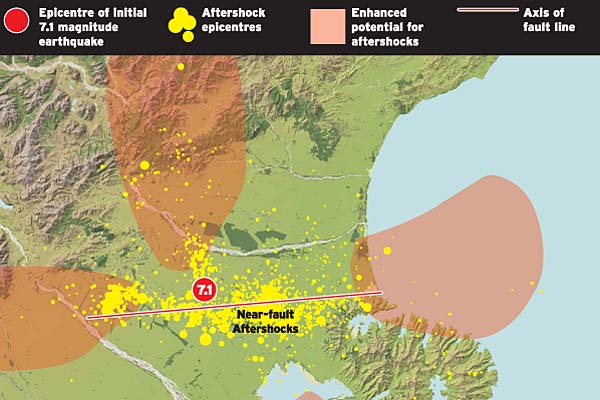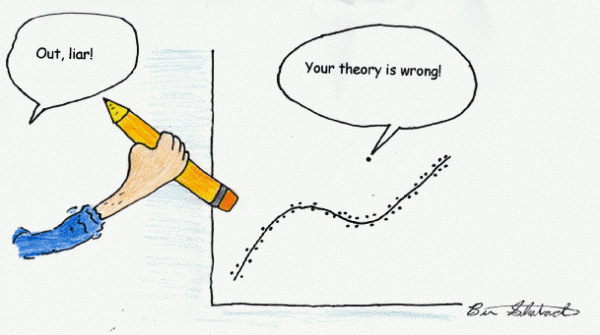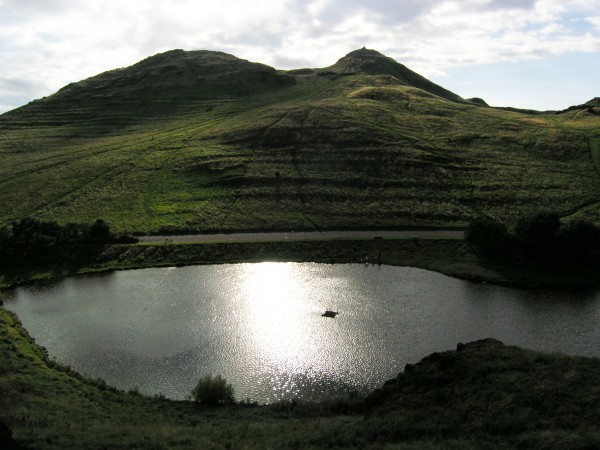![]() Welcome to the Geoblogosphere School of Learning & Doing. Let’s begin with a story by one of our students, Michael Klaas of Uncovered Earth. He writes…
Welcome to the Geoblogosphere School of Learning & Doing. Let’s begin with a story by one of our students, Michael Klaas of Uncovered Earth. He writes…
“On a warm evening in May of 2008 I sat upon a cinder cone along the flank of Mauna Kea and watched the silhouette of Mauna Loa fade into the darkness as the sun set. Between myself and that other summit was a sea of clouds that washed over all but the highest points of the landscape. I looked upon it with awe and I wondered.
Though I loved what I was seeing, I really understood very little about it.”
Following that sunset experience, he realized that
“in order to appreciate a thing, you must first come to know it. And the best place to go when you want to learn about something is college.”
Now he is a geology major at Portland State exploring the directions he might take his career in the geosciences.
It was for people like Michael, as well as for those like myself who are entrusted with educating them, that I decided to focus this Accretionary Wedge on the theme of education and careers. The response has been wonderful and the collective wisdom of the geoblogosphere that has poured forth is a heart-warming and inspiring thing. But in order to avoid getting to misty-eyed about what a great supportive community we have here online, I’ve decided to have a little fun with the carnival entries and organize them into school subjects…of a sort. So let’s begin our school day.
Potions
Are there some absolutely critical skills or pieces of knowledge that provide a recipe to success in geosciences classes or careers? No geoblogger attempted to give an exhaustive answer (and I doubt a single answer exists), but a few brave souls offered their advice on how to brew a successful potion.
Matt of Agile Geoscience entreats us all to learn to program, saying that scientists have a duty to understand how and why computer programs work and how to tinker with them. He says the process will even be sweet tasting: “Programming is a special kind of problem-solving, and rewards thought and ingenuity with the satisfaction of immediate and tangible results. Getting it right, even just slightly, is profoundly elating.” Speaking as a low-level tinkerer with Matlab, I have to grudgingly admit that Matt is onto something there.
Dave Bressan of the History of Geology Blog reminds us that while academics can get lost in abstract concepts, in the real world, when a landslide has destroyed a bridge and threatens buidlings on the edge, “who you gonna call? APPLIED GEOLOGISTS…” Dave writes that “Students must be aware that the private sector demands exact, however fast and cheap (…unfortunately) results. …On the bright side it is a work that demands motivation, experience and knowledge to approach various, often very variable, problems.” Ann of Ann’s Musings on Geology and Other Things offers another example in which a traditional geology education is sometimes a mismatch with the real world, as she makes a good case for taking some business classes alongside those fun geology electives. Newly-minted graduate Emily advises using internships to “figure out what you DON’T want to do”, and reckons that you should have GIS is in your transferable skill-set.
Silver Fox of Looking for Detachment offers advice from the minerals exploration industry. She’s got a fantastic set of recommendations, but the last point deserves special attention: “So, I say, learn the basics, which include rocks and minerals, and learn basic field mapping skills. Especially learn how to find out things you don’t know. Ask questions, try to find answers.”
The quest for knowledge brings us to our next class of posts…
Transfiguration
Maitri of Maitri’s VatulBlog takes Silver Fox’s theme one step further, arguing that the most important thing a scientist can do is learn how to learn. She says “knowing scientific results is important, but how to arrive at those and new states of knowledge is most critical.” Well said.
Denise Tang of Life as a Geologist echoes Maitri’s sentiments by encouraging us to always be prepared to learn new things, and that further we must be prepared to challenge the conventional ideas when we have reason to do so. That’s a bold statement coming from someone in the Chinese culture, but Denise writes “Daring to challenge others, and be able to defend your own idea, to me, is a paramount important thing here.” On the other hand, I make a plea to let mentors help you learn by having data-driven discussions early and often.
My co-blogger at Highly Allochthonous, Chris Rowan, reminds us not to let ourselves get too pigeonholed into a single nipple of knowledge and to fight the intellectual narrows.
Learning how to learn will prove particularly effective when confronted by the menacing shadow of chalk boards filled with formulae and definitions.
Defense Against the Dark Arts (of Dull Lectures)
Dear students, if you didn’t retain very much of that brilliant lecture your professor just gave, it’s not your fault, we need be more effective teachers, not just lecturerers, explains Narnian Rockhound of Earth-like Planet. Part of the problem, as Jessica Ball of Magma Cum Laude points out, is that grad school usually does very little to prepare people to be good teachers.
So what can the teachers do better? Narnia and Jessica offer up some suggestions, and a few other bloggers have great specific examples. Maybe your professor just wants you to take away the scaffolding and conceptual structure that has more long-term utility than a head stuffed full of disconnected facts. At least that’s what MK at Research at a Snail’s Pace thinks. Shawn of Vi-Carius, who has both the student and the teacher’s perspective as a grad student teaching assistant, begs professors to remember to teach with real-world applications, because that’s what helps students understand complicated theories. In a similar vein, Abdelrhman, author of the GeoSelim blog, thinks that professors should focus on application over narration, arguing “Don’t tell your student the story, teach them how to tell a good story.”
Julia at Stages of Succession reminds us that doing data collection in the field is the best way to teach students about the real process of science. Ryan of Glacial Till says its not just up to the teachers to teach the process of science; students should also seek out opportunities to do research and get hands-on experiences. He hopes that such experiences will help him find a good job that matches his interests when he is done with school.
But even if you’ve never set foot on the grounds of a university campus, there’s still a world of geology waiting to be learned about, and the geology enthusiasts who embrace informal education are among the most valued members of our school.
Care of Magical Creatures
Ron Schott of the Geology Home Companion Blog writes that “there’s more to teaching and learning than exists on a campus or in a classroom.” After 10 years of university teaching he’s left that classroom, and he will be devoting some more of his time to exploring online communication tools as a vehicle for teaching geology. Hollis of In the Company of Plants and Rocks would urge Ron to spend his time creating virtual field trips. He says “What stokes my enthusiasm? — locations with photos, maps and explanations, the more the better. Whenever I find information about an intriguing geologic feature in western North America, I make note, and I design my vacation road trips around these places!”
Dana Hunter of En Tequila Es Verdad gives Ron some more good guidance for the sorts of non-classroom teaching we can do and how that can reach someone like her, who has no formal training in geology but has nonetheless fallen in love with the earth sciences. Her enthusiasm for geology shines through in her post “Adorers of the Good Science of Rock Breaking” and for professional geosciences teachers it should be required reading for renewing our inspiration. (Note also that Dana has recently changed her web abode. She can now be found on FreeThoughtBlogs.)
Of course, Geoscientists shouldn’t limit ourselves to only sharing information and resources with the magical creatures who have already fallen in love with geology.
Charms
As Nahúm Méndez Chazarra of Un geólogo en apuros writes, geology is all too often an invisible science, and we need to popularize it, because after all we are all sitting on the Earth’s crust. Ryan of Educated Erosion shows us first-hand the impact of Nahúm’s “invisible science” observation. Ryan writes: “I wish somebody would have told me in High School that you could study Geology in college and what you could do with that education. I honestly didn’t even know that Geologists did actual science. I thought they were more technicians in mines or the oil fields…” Now he is a geology major in New Mexico with aspirations to work in planetary science.
Flying
We’ve mostly concluded our tour of the Geoblogosphere School of Learning & Doing for today, and I hope you’ve enjoyed the class rosters. Now it’s time to get onto the doing part, and I hope you are feeling inspired by all of the good advice and stories you’ve just read, because we need to help more students fall in love with geology. It’s October and time for the DonorsChoose Science Bloggers for Students Challenge, when we generously give money to help US schoolchildren get hands-on science education. While I’m too overwhelmed to set up a challenge myself this year, I’d like to encourage you to donate to the several geobloggers who have set up challenges. Take a look at the great projects picked out by Maitri Erwin, Jacquelyn Gill, Dana Hunter, and the folks at The Gam and Deep Sea News.
Right, now who’s up for some flying?











Nice plan for content warnings on Mastodon and the Fediverse. Now you need a Mastodon/Fediverse button on this blog.